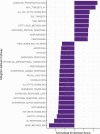Early Changes in Immune Cell Count, Metabolism, and Function Following Sleeve Gastrectomy: A Prospective Human Study
- PMID: 34514501
- PMCID: PMC8764221
- DOI: 10.1210/clinem/dgab673
Early Changes in Immune Cell Count, Metabolism, and Function Following Sleeve Gastrectomy: A Prospective Human Study
Abstract
Objective: To characterize longitudinal changes in blood biomarkers, leukocyte composition, and gene expression following laparoscopic sleeve gastrectomy (LSG).
Background: LSG is an effective treatment for obesity, leading to sustainable weight loss and improvements in obesity-related comorbidities and inflammatory profiles. However, the effects of LSG on immune function and metabolism remain uncertain.
Methods: Prospective data were collected from 23 enrolled human subjects from a single institution. Parameters of weight, comorbidities, and trends in blood biomarkers and leukocyte subsets were observed from preoperative baseline to 1 year postsurgery in 3-month follow-up intervals. RNA sequencing was performed on pairs of whole blood samples from the first 6 subjects of the study (baseline and 3 months postsurgery) to identify genome-wide gene expression changes associated with undergoing LSG.
Results: LSG led to a significant decrease in mean total body weight loss (18.1%) at 3 months and among diabetic subjects a reduction in hemoglobin A1c. Improvements in clinical inflammatory and hormonal biomarkers were demonstrated as early as 3 months after LSG. A reduction in neutrophil-lymphocyte ratio was observed, driven by a reduction in absolute neutrophil counts. Gene set enrichment analyses of differential whole blood gene expression demonstrated that after 3 months LSG induced transcriptomic changes not only in inflammatory cytokine pathways but also in several key metabolic pathways related to energy metabolism.
Conclusions: LSG induces significant changes in the composition and metabolism of immune cells as early as 3 months postoperatively. Further evaluation is required of bariatric surgery's effects on immunometabolism and the consequences for host defense and metabolic disease.
Keywords: bariatric surgery; inflammation; leukocytes; metabolism; sleeve gastrectomy; transcriptomics.
© The Author(s) 2021. Published by Oxford University Press on behalf of the Endocrine Society. All rights reserved. For permissions, please e-mail: journals.permissions@oup.com.
Figures






Update of
-
Early changes in immune cell metabolism and function are a hallmark of sleeve gastrectomy: a prospective human study.medRxiv [Preprint]. 2020 Nov 3:2020.07.31.20161687. doi: 10.1101/2020.07.31.20161687. medRxiv. 2020. Update in: J Clin Endocrinol Metab. 2022 Jan 18;107(2):e619-e630. doi: 10.1210/clinem/dgab673. PMID: 33173925 Free PMC article. Updated. Preprint.
References
-
- Hotamisligil GS, Shargill NS, Spiegelman BM. Adipose expression of tumor necrosis factor-alpha: direct role in obesity-linked insulin resistance. Science. 1993;259(5091):87-91. - PubMed
-
- Hotamisligil GS. Inflammation, metaflammation and immunometabolic disorders. Nature. 2017;542(7640):177-185. - PubMed
Publication types
MeSH terms
Grants and funding
LinkOut - more resources
Full Text Sources
Medical

